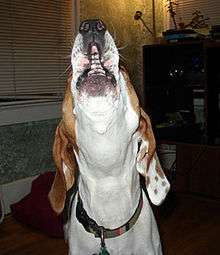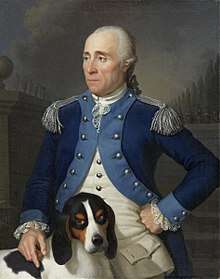Scent hound
Scent hounds (or scenthounds) are a type of hound that primarily hunts by scent rather than sight. These breeds are hunting dogs and are generally regarded as having some of the most sensitive noses among dogs.


Hounds are hunting dogs that either hunt by following the scent of a game animal (scenthounds) or by following the animal by sight (sighthounds). There are many breeds in the scenthound type, and scenthounds may do other work as well, so exactly which breeds should be called scenthound can be controversial. Kennel clubs assign breeds of dogs to Groups, which are loosely based on breed types. Each kennel club determines which breeds it will place in a given group.
Scent hounds specialize in following a smell or scent. Most of these breeds have long, drooping ears. One theory says that this trait helps to collect scent from the air and keep it near the dog's face and nose. They also have large nasal cavities, which helps them smell better. Their typically loose, moist lips are said to assist in trapping scent particles.
Most of these breeds have deep, booming voices and use them actively when running, and especially when following a scent trail. Although this can be a nuisance in settled areas, it is a valuable trait that allows the dog's handler to follow the dog or pack of dogs during a hunt even when they are out of sight, such as when following a fox or raccoon through woodland.
Scent hounds do not need to be as fast as sight hounds, because they do not need to keep prey in sight, but they need endurance so that they can stick with a scent and follow it for long distances over rough terrain. The best scent hounds can follow a scent trail even across running water and even when it is several days old. Most scent hounds are used for hunting in packs of multiple dogs. Longer-legged hounds run more quickly and usually require that the hunters follow on horseback; shorter-legged hounds allow hunters to follow on foot. Hunting with some breeds, such as German Bracke, American Foxhounds, or coonhounds, involves allowing the pack of dogs to run freely while the hunters wait in a fixed spot until the dogs' baying announces that the game has been "treed". The hunters then go to the spot on foot, following the sound of the dogs' baying.[1]
The Fédération Cynologique Internationale (FCI) places scent hounds into their classification "Group 6". This includes a subdivision, "Section 2, Leash Hounds", some examples of which are the Bavarian Mountain Scenthound (Bayrischer Gebirgsschweisshund, no. 217), the Hanoverian Scenthound (Hannover'scher Schweisshund, no. 213), and the Alpine Dachsbracke (Alpenländische Dachsbracke, no. 254). In addition, the Dalmatian and the Rhodesian Ridgeback are placed in Group 6 as "Related breeds".
The United Kennel Club divides its Scenthound Group into two categories. The first, Tree Hounds, includes the American hunting dogs known as coonhounds and the European hounds from which they were developed. The second category is named Trailing Scenthounds, and includes dogs used for the tracking of game animals, and of humans (as in search-and-rescue, and fugitive capture). They are also used for explosives detection. The Trailing group are reputedly descended from a type of bloodhound kept by monks in Belgium.[2]
History
It is believed that scent hounds were bred from mastiff-type dogs by the Celts, long before the Christian era. They realized that some of the mastiff dogs had superior scenting ability and used them for hunting. The Celts selectively bred mastiffs that were best at following a trail, and may have later cross-bred them with sighthounds. Over the years, scent hounds became less bulky, with a lighter bone structure and an obliging temperament, but maintained the pendulous ears and thick, heavy skin. Their new traits allowed them to move faster, not get tired easily, and be more controllable during the hunt.[3]
Genetic history
Genetic studies indicate that the scent hounds are more closely related to each other than they are with other branches on the dog family tree.[4]
Breeds
The scent hound type includes the following breeds:
- Alpine Dachsbracke
- American Foxhound
- Anglo-French hounds (crossed with English Foxhounds)
- Anglo-Français de Petite Vénerie
- Grand Anglo-Français Tricolore
- Grand anglo-français blanc et orange
- Grand anglo-français blanc et noir
- Ariegeois
- Artois Hound
- Austrian black and tan hound
- Basset Artesien Normand
- Basset Bleu de Gascogne
- Basset Fauve de Bretagne
- Basset Hound
- Bavarian Mountain hound
- Beagle
- Beagle-Harrier
- Berner Laufhund
- Bloodhound
- Catahoula Leopard Hound
- Coonhound
- Black and Tan Coonhound
- Redbone Coonhound
- Bluetick Coonhound
- English Coonhound (Redtick Coonhound)
- Treeing Walker Coonhound
- Plott Hound
- Dachshund
- Drever
- Dunker
- English Foxhound
- Estonian Hound
- Finnish Hound
- Foxhound
- Français tricolore
- Français blanc et noir
- Français blanc et orange
- Gascon Saintongeois
- Grand Basset Griffon Vendeen
- Grand Bleu de Gascogne
- Greek Harehound
- Hamiltonstövare
- Hanover Hound
- Harrier
- Hungarian hound
- Istrian Coarse-haired Hound
- Istrian Shorthaired Hound
- Kerry Beagle
- Kritikos Ichnilatis (Cretan Hound)
- Montenegrin Mountain Hound
- Norwegian Lundehund
- Otterhound
- Petit Basset Griffon Vendeen
- Perro fino Colombiano
- Piccolo Lepraiolo Italiano
- Plott Hound
- Polish Hound (pl. Ogar Polski )
- Polish Scenthound (pl. Gonczy Polski )
- Porcelaine
- Posavac Hound
- Rache (obsolete)
- Sabueso Español (Spanish Scenthound)
- Segugio Italiano a Pelo Forte
- Segugio Italiano a Pelo Raso
- Segugio Maremmano
- Serbian Hound
- Serbian Tricolour Hound
- Schweizer Laufhund
- Slovensky Kopov (Slovakian Hound)
- Talbot (extinct)
- Treeing Walker Coonhound
- Westphalian Dachsbracke
United Kennel Club Scenthound Group
The Scenthound Group is the group category used by the United Kennel Club (US), which it divides into two categories. The first includes the American hunting dogs known as coonhounds and the European hounds from which they were developed. These are referred to as Tree Hounds. The category also includes curs, American dogs bred for hunting bears, feral pigs, and similar large game. The second category is referred to as trailing scenthounds, and includes dogs used for tracking of humans, reputedly descended from the St. Hubert Hounds (ancestor of today's Bloodhound breed) kept by monks in Belgium.[5]
See also
- Breed group (dog)
- Dog type
- Sighthound
- Sighthound & Pariah Group
- Hound
- Hound Group
- Hunting dog
References
- Coon hunting on ESPN
- United Kennel Club (US) breed information Archived 2011-01-03 at the Wayback Machine
- https://www.akc.org/sports/field-events-hounds/coonhound/scenthound-history/
- vonHoldt, Bridgett M.; John P. Pollinger; Kirk E. Lohmueller; Eunjung Han; Heidi G. Parker; Pascale Quignon; Jeremiah D. Degenhardt; Adam R. Boyko; Dent A. Earl; Adam Auton; Andy Reynolds; Kasia Bryc; Abra Brisbin; James C. Knowles; Dana S. Mosher; Tyrone C. Spady; Abdel Elkahloun; Eli Geffen; Malgorzata Pilot; Wlodzimierz Jedrzejewski; Claudia Greco; Ettore Randi; Danika Bannasch; Alan Wilton; Jeremy Shearman; Marco Musiani; Michelle Cargill; Paul G. Jones; Zuwei Qian; Wei Huang; Zhao-Li Ding; Ya-ping Zhang; Carlos D. Bustamante; Elaine A. Ostrander; John Novembre; Robert K. Wayne (8 April 2010). "Genome-wide SNP and haplotype analyses reveal a rich history underlying dog domestication". Nature. 464 (7290): 898–902. doi:10.1038/nature08837. ISSN 0028-0836. PMC 3494089. PMID 20237475.
- United Kennel Club (US) breed information Archived 2011-01-03 at the Wayback Machine